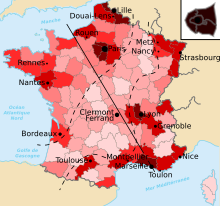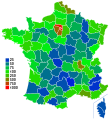
Lozère is a landlocked department in the region of Occitanie in Southern France, located near the Massif Central, bounded to the northeast by Haute-Loire, to the east by Ardèche, to the south by Gard, to the west by Aveyron, and the northwest by Cantal. It is named after Mont Lozère. With 76,604 inhabitants as of 2019, Lozère is the least populous French department.

Hautes-Alpes is a department in the Provence-Alpes-Côte d'Azur region of Southeastern France. It is located in the heart of the French Alps, after which it is named. Hautes-Alpes had a population of 141,220 as of 2019, which makes it the third least populated French department. Its prefecture is Gap; its sole subprefecture is Briançon. Its INSEE and postal code is 05.
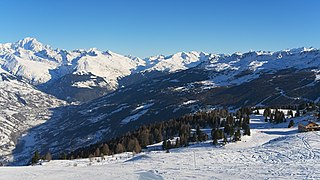
Savoie is a department in the Auvergne-Rhône-Alpes region, Southeastern France. Located in the French Alps, its prefecture is Chambéry. In 2019, Savoie had a population of 436,434.

Cantal is a rural department in the Auvergne-Rhône-Alpes region of France, with its prefecture in Aurillac. Its other principal towns are Saint-Flour and Mauriac; its residents are known as Cantalians. Cantal borders the departments of Puy-de-Dôme, Haute-Loire, Aveyron, Lot, Lozère and Corrèze, in the Massif Central natural region.
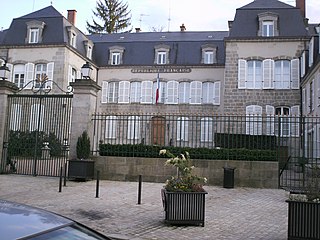
Creuse is a department in central France named after the river Creuse. After Lozère, it is the second least populated department in France. It is bordered by Indre and Cher to the north, Allier and Puy-de-Dôme to the east, Corrèze to the south, and Haute-Vienne to the west. In 2020, the population of this department is 115,995, while the official estimates in 2022 is 113,711.

Haute-Saône is a department in the Bourgogne-Franche-Comté region of northeastern France. Named after the river Saône, it had a population of 235,313 in 2019. Its prefecture is Vesoul; its sole subprefecture is Lure.

Yonne is a département in the Bourgogne-Franche-Comté region in France. It is named after the river Yonne, which flows through it, in the country's north-central part. One of Bourgogne-Franche-Comté's eight constituent departments, it is located in its northwestern part, bordering Île-de-France. It was created in 1790 during the French Revolution. Its prefecture is Auxerre, with subprefectures in Avallon and Sens. Its INSEE and postcode number is 89.

Saint-Jean-de-Maurienne is a subprefecture of the Savoie department, in the region of Auvergne-Rhône-Alpes, Southeastern France.

Paul Vidal de La Blache was a French geographer. He is considered to be the founder of modern French geography and also the founder of the French School of Geopolitics. He conceived the idea of genre de vie, which is the belief that the lifestyle of a particular region reflects the economic, social, ideological and psychological identities imprinted on the landscape.

Eaux-Bonnes is a commune in the Pyrénées-Atlantiques department in south-western France.

Saint-Avé is a commune in the Morbihan department of Brittany in north-western France. It's the 8th most populated commune of the Morbihan department and the 32nd of the Brittany region with its population of 11,787 inhabitants in 2018.
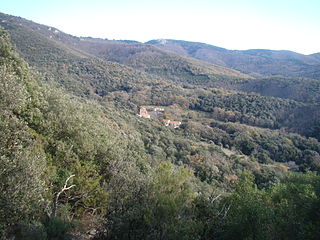
L'Albère is a commune in the Pyrénées-Orientales department in southern France.

Maxilly-sur-Saône is a commune in the Côte-d'Or department in the Bourgogne-Franche-Comté region in eastern France. The inhabitants are called Maximilliens and Maximilliennes.
Talasani is a rural commune and village on the eastern seaboard of Corsica, in the Haute-Corse department of France. The area has a very low population density and mainly comprises forests and farmland. As a coastal municipality, Talasani enforces strict urban planning provisions in order to preserve the ecological balance of the coast.

La Meilleraye-de-Bretagne is a commune in the Loire-Atlantique department in western France.
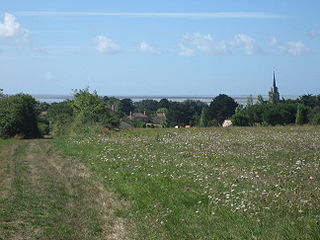
Les Moutiers-en-Retz is a commune in the Loire-Atlantique department in western France.
Champvoisy is a commune in the Marne department in north-eastern France. It is a rural municipality, with a very low population density. The municipality is part of the functional area of Reims, which is composed of 294 municipalities.

Jean-Hervé Lorenzi is a French economist.

Hervé Le Bras is a French demographer and historian.

Hubert Boulard was a French comics writer and colorist usually credited mononymously as "Hubert".
